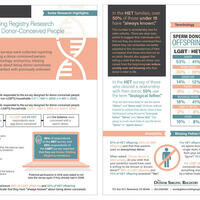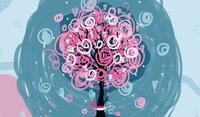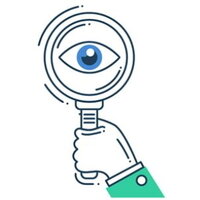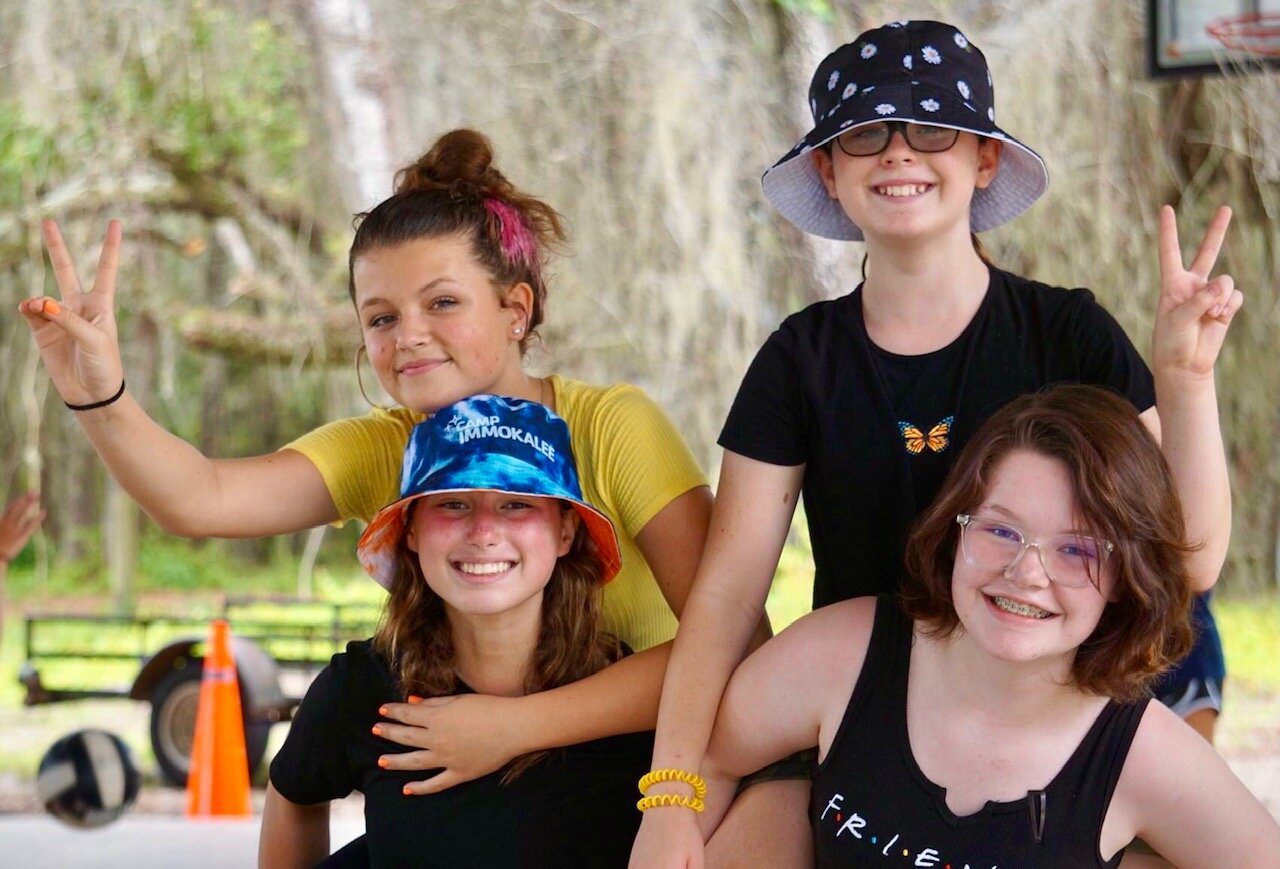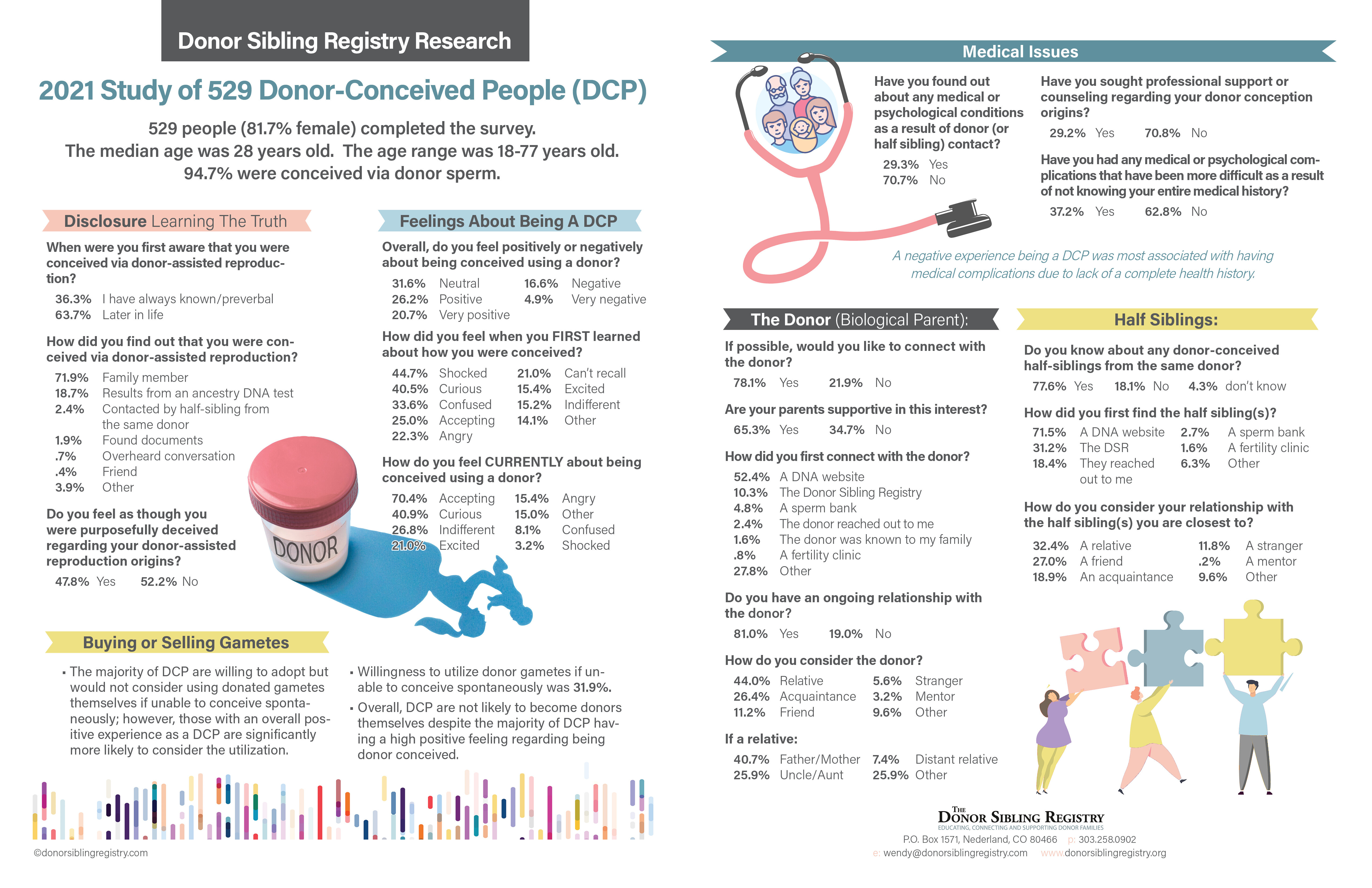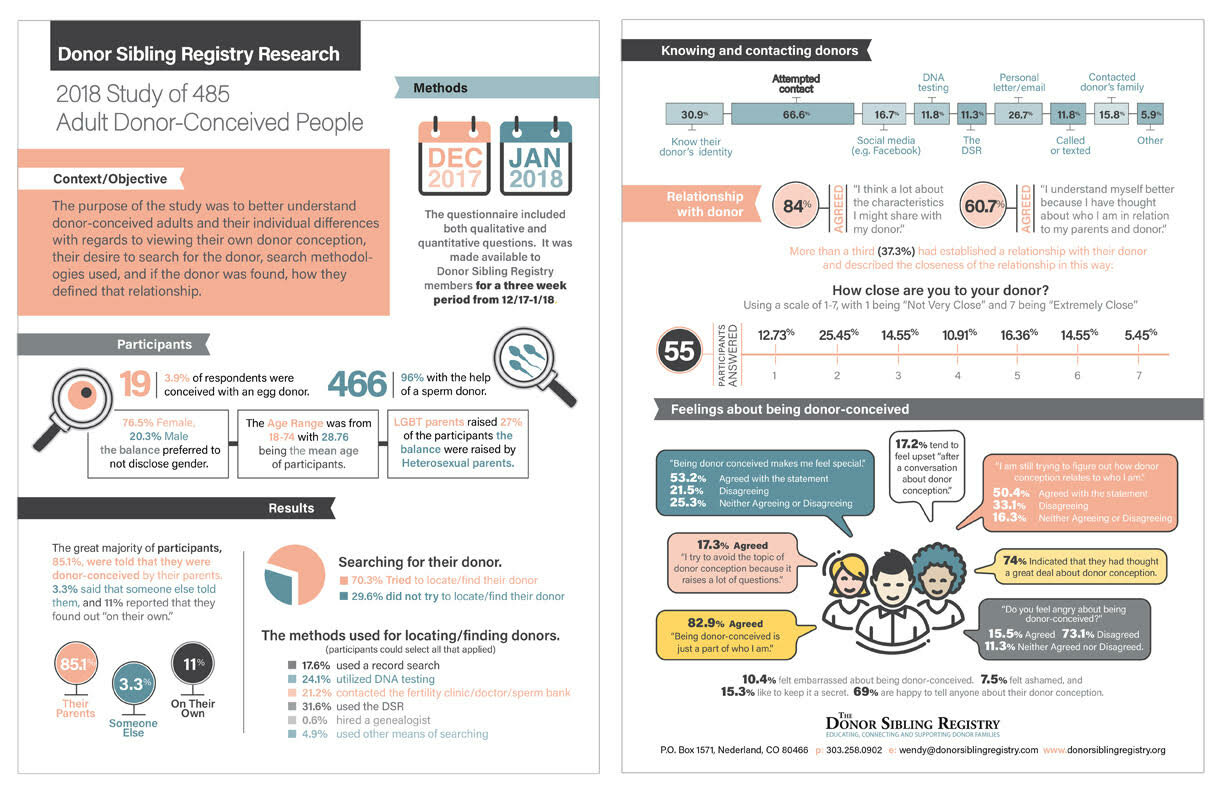DSR Research
The Donor Sibling Registry regularly conducts research on all members of the donor family, including egg and sperm donors, bio and non-bio parents, donor-conceived people, and donor grandparents. The DSR has conducted and published research on many donor family issues. Some of this research has been in collaboration with the University of Cambridge (UK), the University of California at San Francisco, the University of Illinois at Chicago, the University of Colorado School of Medicine, the University of Canterbury (NZ), California State University, the University of California at San Francisco (UCSF), and many other universities and prominent private researchers.
Current & Recent Research
2024: A collaboration with Victoria University, Melbourne, Australia. 2 studies: (1) the lived experiences of single dads by choice; and (2) gay dads (single or coupled) who have reached out to the egg donor of their children.

Published Research
The DSR's Research Tree Booklet: While we feel that it’s extremely important that all stakeholders are properly educated, we realize that not everyone is interested in reading a stack of academic articles on the subject. Additionally, those who provide counseling services and other professional services to parents, offspring, and donors, as well as those thinking critically about the issues with regard to setting policy, might have fallen behind on the latest research. This is why we put together the Donor Sibling Registry’s Research Tree booklet — a summary of some of our peer-reviewed/published research papers. It’s the “Cliff Notes” of DSR research, studying all those in the donor family: the parents (biological and non-biological) of egg and sperm donor children, the egg and sperm donors, the offspring, and even the parents of people who have donated (the “donor grandparents”).
Kirby Adlam, Ph.D., Mary Dawn Koenig, Ph.D., Crystal L. Patil, Ph.D., Aana Steffen, Ph.D., Sana Salih, M.D., Wendy Kramer, B.A., Patricia E. Hershberger, Ph.D. DOI: 10.1016/j.fertnstert.2024.12.019
This research was presented by our partners from the University of Illinois at Chicago Dept. of Population Health Nursing Science/ Dept. of Obstetrics & Gynecology at the American Society of Reproductive Medicine (ASRM) 2022 Scientific Congress & Expo. This abstract was presented with the ASRM's Nurses' Professional Group's best abstract award and the ASRM's Mental Health Professional Group's best abstract award at the ASRM annual conference in 2022. This study yielded 345 completed surveys and was also presented at the MNRS (Midwest Nursing Research Society) conference in March 2022 and at the American College of Nurse-Midwives annual meeting in May 2022.
Human Reproduction
Dana R. Siegel, Jeanelle Sheeder, Wendy Kramer, Cassandra Roeca
Human Reproduction, pp. 1–8, 2022 https://doi.org/10.1093/humrep/deac169
Donor-conceived people view their donor conception as an important part of their self-identity and many desire contact with genetically related individuals. Additionally, many believe that sperm donation should only be practiced if identifying information on the donor is provided. Donor-conceived people are not likely to become donors themselves despite the majority having a high positive feeling regarding being donor-conceived.
Fertility and Sterility
Fertility and Sterility, Published on 01 Sep 2021
DOI: https://doi.org/10.1016/j.fertnstert.2021.07.1156 Dana R. Siegel, Jeanelle Sheeder, Wendy Kramer, Cassandra Roeca.
Donor-conceived people are more likely to have positive feelings surrounding their conception if they are told at a young age by a family member and have regularly updated and accessible medical information.
Collaboration with the University of Colorado School of Medicine, Reproductive Endocrinology & Infertility Department. Donor-conceived people research study. The study had 529 donor-conceived people respond. The following 3 abstracts were published in Fertility and Sterility in September of 2021:
1. How experience frames donor-conceived people's feelings about utilizing donor-assisted reproduction themselves: insights from individuals conceived via donor-assisted reproduction. Dana R. Siegel, Jeanelle Sheeder, Wendy Kramer, Cassandra Roeca
The majority of donor-conceived people are willing to adopt but would not consider using donated gametes themselves if unable to conceive spontaneously; however, those with an overall positive experience in regards to their donor conception are significantly more likely to consider the utilization.
2. Where are the donors? Do donor-conceived people become donors themselves? John Rushing, Dana R. Siegel, Wendy Kramer, Jeanelle Sheeder, Cassandra Roeca.
Overall, donor-conceived people are not likely to become donors themselves, and having an overall positive experience being donor-conceived did not affect this decision.
3. The age and by whom a donor-conceived person receives information significantly affects their experience.

Advance Medical and Clinical Research
The Donor Conceived Adult: Implications Within Family, Medical, and Mental Healthcare Systems
Volume 2 | Issue 1 | 16-17
Introduction: The utilization of alternative approaches to creating families, including the use of donors and embryo adoptions, has increased exponentially in recent years. Previously, adoption and donor conception were kept secret from the offspring, but with the recent popularity of commercial DNA testing, large numbers of individuals are discovering for the first time as adults that they were donor-conceived (DC) decades prior. As DC adults are increasingly likely to present to mental health professionals for this or other unrelated issues, an understanding of the DC adult, particularly within the context of the family, the treatment, and across healthcare systems is critical.
Method and Results: This article discusses current knowledge of the experience of DC adults and their functioning within family, therapeutic, and healthcare systems. Although major pathology has not been identified in this group, they demonstrate a unique set of challenges and strengths. More research is critical to characterizing these individuals for the purposes of developing interventions as reproductive medicine continues to expand the use of methods like donor conception.
Discussion: DC adults represent a rapidly growing group of individuals with distinct needs within family systems and healthcare. As mental healthcare systems have become better equipped to meet the needs of prospective parents who are likely to utilize these alternative methods of conception, including individuals with infertility, same-sex couples, and single parents, we must also prepare to support current and future generations of offspring who were conceived using these methods.
Personal Relationships (Journal of the International Association for Relationship Research)
Attachment in donor-conceived adults: Curiosity, search, and contact
Elizabeth B. Lozano, R. Chris Fraley, and Wendy Kramer
DOI: 10.1111/pere.12273
This was from a research project with partners at the University of Illinois at Urbana-Champaign that was also a poster presentation at the 2018 ASRM meeting in October 2018.
"The present study examined whether individual differences in attachment predict adults’ self-reported curiosity about their donor conception identity, as well as attempts to find the donor and establish contact. Contrary to our prediction, there was no association between individual differences in attachment and one’s search for the donor. Attachment was also unrelated to whether or not a contact attempt had been made. However, results indicated that participants high in attachment anxiety were more curious about their donor conception, albeit disengaged from it. These findings suggest that insecure attachment — in particular, attachment anxiety — may contribute to individual variability in a person’s willingness to incorporate donor conception into his/her identity."
Some other highlights from the surveys:
Reproductive BioMedicine Online
Long-term breast cancer risk following ovarian stimulation in young egg donors: a call for follow-up, research and informed consent
J. Schneider, MD, J. Lahl, and W. Kramer
"In the USA and other countries, oocyte donation is gaining increasing importance. Although sufficient data exist on procedure-associated short-term risks for oocyte donors, such as ovarian hyperstimulation syndrome, long-term follow-up studies of egg donors are lacking and their health risks are unknown. The lack of information may be misleadingly interpreted as lack of risk. Long-term hormone replacement therapy is recognized as a risk factor for breast cancer; the breast cancer risk of ovarian stimulation for egg donors is unknown but is a possibility. This commentary describes five individual cases of egg donors who developed breast cancer (four out of five women in their 30s) despite negative genetic testing results. Additionally, we summarize available studies of breast cancer in infertile women who experienced IVF. We emphasize the need to create egg donor registries that will facilitate long-term studies on egg donors. Until this information is available, we call for more realistic explanations to egg donors about the lack of knowledge of long-term risks as well as more transparent informed consent documents."
September 2017: Here is an earlier version of the paper and its related table. We think this version is important to share because we had significant difficulty getting the article published; after an initial outright rejection, we had to go through multiple revisions and requests to eliminate material that we felt was essential to the paper. We had doubts along the way about whether the paper would ever be accepted because it emphasizes the need for egg donor registries.
The main messages of both versions are the same:
(1) There has been no long-term follow-up of egg donors, with the result that, so many years after the beginning of hormonal stimulation for egg donation, we still do not know if there are any long-term health risks such as various cancers or infertility for the young women who donated eggs.
(2) Young women who are told that “there are no known long-term risks” often do not understand that this does NOT mean “there ARE no long-term risks” and do not realize that this is uncharted territory.
The solution is (1) To implement egg-donor registries and begin long-term studies of these women and (2) Meanwhile, begin to provide straightforward information to potential donors about the fact that currently we DO NOT KNOW what the risks are. What is different about the early version of the paper is that it includes additional perspectives directed at an American audience, in that pages 14-17 speak more to institutions such as the U.S. Centers for Disease Control (CDC) and National Institutes of Health (NIH) and to the need for American organizations such as SART and ASRM to provide more transparent "informed consent” forms to donors. These statements were removed from the final version. We were also asked to remove the last sentence (about informed consent) in case D and the quote in the description of case E, regarding her experience at the IVF clinic.
Fertility and Sterility
Integrating donor conception into identity development: adolescents in fatherless families
DOI: https://doi.org/10.1016/j.fertnstert.2016.02.033 (PDF)
Jenna Slutsky, M.A., Vasanti Jadva, Ph.D., Tabitha Freeman, Ph.D., Howard Steele, Ph.D., Wendy Kramer, B.A., Susan Golombok, Ph.D.
"This study was undertaken by the Centre for Family Research (CFR) at the University of Cambridge in collaboration with the New School in NY and the Donor Sibling Registry (DSR). "Adolescents who were securely attached to their mothers were more accepting of their donor conception than insecurely attached adolescents, suggesting that quality of mother-child relationships influences feelings about donor conception."
January 2019 letter from Fertility and Sterility: "We would like to offer our congratulations as your article secured 1097 downloads and 6 citations by the end of 2018, contributing to the journal’s tradition of publishing impactful research."
Children & Society
Adolescents Conceived Through Donor Insemination in Mother-Headed Families: A Qualitative Study of Motivations and Experiences of Contacting and Meeting Same-donor Offspring
S. Persaud, T. Freeman, V. Jadva, J. Slutsky, W. Kramer, M. Steele, H. Steele, S. Golombuk
DOI: 10.1111/chso.12158 (PDF)
"This study was undertaken by the Centre for Family Research (CFR) at the University of Cambridge in collaboration with the Donor Sibling Registry (DSR). Twenty-three donor-conceived adolescents aged 12-19 years living in single-mother or dual-parent lesbian households in three US states (New York, New Jersey, or Connecticut) were interviewed about their experiences of contacting and meeting other donor-conceived offspring sharing the same donor but raised in different families via the DSR, their motivations for making this contact, and meaning they make of these relationships. The experience of contacting and meeting same-donor offspring was perceived as being either normal/neutral or as a unique experience that was integrated into adolescents’ identity. This study highlights the importance of these experiences, particularly during adolescence, a developmental stage associated with identity formation and has important policy implications as it suggests that donor-conceived adolescents may benefit from contact with others conceived using the same donor prior to the age of 18 years."
Journal of Family Issues
Donor Sibling Networks as a Vehicle for Expanding Kinship: A Replication and Extension
Rosanna Hertz, Margaret K. Nelson, and Wendy Kramer DOI: 10.1177/0192513X16631018
"This article replicates an earlier study of mothers who had used the same sperm donor to conceive their children and connected through the Internet. The original study finds that these groups interact mainly on the Internet; donor siblings are latent affiliations that could answer questions about the paternal side. This new study of 2,217 parents and 419 offspring offers a comparison of the manner in which these relationships develop, finding that the movement from latent to active ties occurs at a different moment than the earlier study. The data show that parents and offspring interpret relationships with genetic relatives in some ways that are similar. However, offspring are more likely than parents to view donor siblings as members of their extended family. Replication of the original study with a more diverse sample allows us to determine if the basic findings can be generalized to other participants who share the same circumstances."
Reproductive Biomedicine & Society
Emerging models for facilitating contact between people genetically related through donor conception: a preliminary analysis and discussion
M. Crawshaw, K. Daniels, K. Bourne, D. Adams, J.A.P Van Hoof, L. Pasch, W. Kramer, P. Thorn
Social Science & Medicine
Gendering gametes: The unequal contributions of sperm and egg donors
Margaret Nelson, Rosanna Hertz, and Wendy Kramer (PDF)
"This paper compares three groups of gestational mothers who relied on gametes from donors they did not know. The three groups are women who have conceived with donor sperm and their own eggs, women who have conceived with donor eggs and a partner's sperm, and women who have conceived with embryos composed of both donor eggs and donor sperm. The paper explores three issues. First, it considers whether intending parents select sperm and egg donors for different attributes both when they are chosen as the only donor and when they are chosen as donors contributing to an entire embryo. Second, it examines how women imagine the donor. Finally, it looks at how women conceptualize the donor as an individual who contributes to their child's characteristics. Two significant findings emerged in this analysis of survey data. First, the data show that gametes are gendered with different attributes both when those gametes are separate and even more so when seen as complementary parts of a whole. Second, the data show that women minimize the impact of the egg donor (both when a sole contribution and especially when part of the complementary whole) and thus ignore the influence or impact of the egg donor relative to how they make sense of the influence or impact of the sperm donor. The data for this study comes from an online survey developed by the authors."
Journal of Law and the Biosciences
Gamete donor anonymity and limits on numbers of offspring: the views of three stakeholders
Margaret K. Nelson, Rosanna Hertz, and Wendy Kramer (PDF)
"This paper discusses the attitudes of three groups of stakeholders in the world of assisted reproduction: gamete donors, parents who use donated gametes, and offspring conceived with donated gametes with respect to the two issues of donor anonymity and limits on the number of offspring a single donor can produce. The data are drawn from on-line surveys which were made available between May 12, 2014 and August 15, 2014 to gamete donors, donor-conceived offspring, and parents who used donated gametes to conceive. A total of 325 donors (176 egg donors; 149 sperm donors) responded to the survey as did 2134 parents and 419 offspring. The data show that offspring are more opposed to donor anonymity than are parents and donors. Among offspring, opposition to anonymity grows as they age. On the other hand, parents are most in favor of limits on numbers of offspring produced by a single donor. Parents worry about health and accidental contact between people conceived from the same donor."
Facts, Views & Vision in OB/GYN (International Journal of the Flemish Society for Obstetrics, Gynaecology & Reproductive Health)
Sperm donors describe the experience of contact with their donor-conceived offspring
Facts Views Vis Obgyn, 2015, 7 (2): 91-100 (PDF)
"This study explores the attitudes and experiences of 57 sperm donors who responded to a survey posted online in the United States and indicated that they had had contact with their donor-conceived offspring or the parents of their donor-conceived offspring. On average, 18 years had elapsed since the respondents donated sperm. In the interim between donating and having contact with offspring, most had become curious about their offspring. Most made contact through a bank or online registry. Most respondents had communicated with at least one offspring at least once and most had exchanged photos with offspring. Approximately two-thirds had met in person once; the same proportion had communicated over email or text. Other forms of communication were less common. Almost half of the respondents now considered their donor-conceived offspring to be like a family member. At the same time, donors are respectful of the integrity of the family in which their offspring were raised. Donors with contact are open to having their partners and children know their donor-conceived offspring. Although contact is generally positive, donors report that establishing boundaries and defining the relationship can be very difficult. Some donors also urge those who are thinking of donating to consider the consequences and some suggest avoiding anonymity. There were no significant differences in attitudes and experiences between those who donated anonymously and those who had been identity-release for their offspring when they turned 18."
Contemporary Perspectives in Family Research
Making Sense of Donors and Donor Siblings: A Comparison of the Perceptions of Donor-Conceived Offspring in Lesbian-Parent and Heterosexual-Parent Families
Our chapter is in Volume 7, 1-42, Theme: "Visions of the 21st Century Family: Transforming Structures and identities." (Note: We are not allowed to distribute the final edited chapter, so the PDF is our submitted paper.)
Reproductive BioMedicine Online
A survey of 1700 women who formed their families using donor spermatozoa
DOI: https://doi.org/10.1016/j.rbmo.2013.07.009 (PDF)
"This paper reports the results of an online survey of 1700 recipients of donor spermatozoa conducted by the Donor Sibling Registry, aiming to understand the perspectives of respondents who had used donor spermatozoa. The survey examined: choice of sperm bank and donor; reporting of births and genetic disorders; disclosure; contact with donor and half-siblings; regulation of sperm donor activity and genetic testing; and access to medical information. The respondents formed three groups: single women; women in a same-sex relationship; and women in a heterosexual relationship. Some differences between the three cohorts were observed: preinsemination counseling; acceptance of donors without medical records or with chronic or late-onset diseases; awareness of choice of bank and type of donor; and views on the right of offspring to know their genetic origins. However, important areas of common ground were identified: the wish by those who had used an anonymous donor that they had used an open-identity donor; support for, and willingness to pay for, comprehensive genetic testing of donors; and desire for access to their donor’s family health information. The implications of these results for policies concerning the use and management of donor spermatozoa will be discussed."
Donor Sibling Registry Research: Sperm Donors
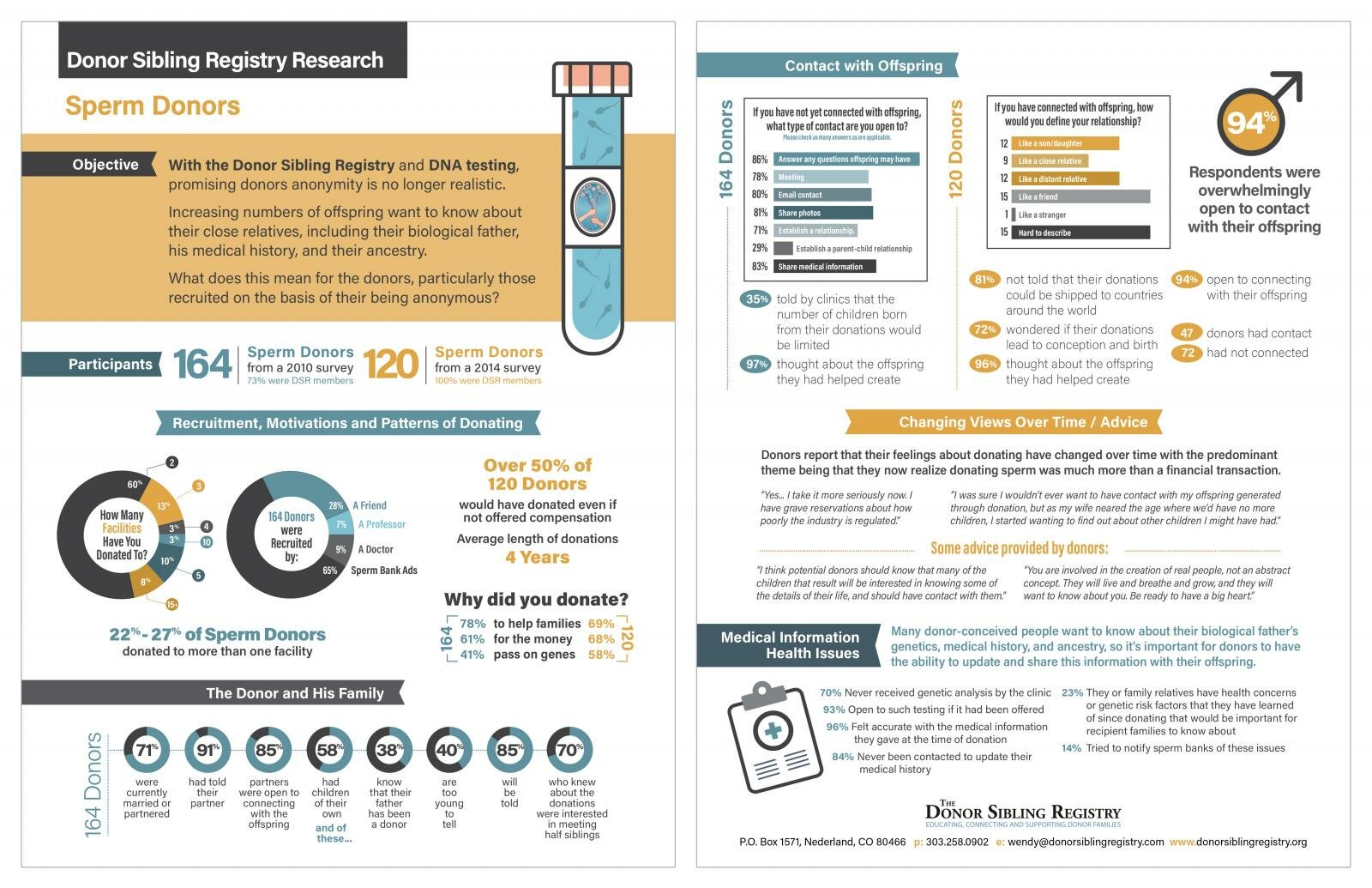
Advances in Reproductive Sciences
Genetic and health issues emerging from sperm donation — The experiences and views of donors
Ken Daniels and Wendy Kramer
Vol 1, No. 3, p. 15-20, November 2013 (PDF)
This paper looks at medical, genetic, and recruitment issues.
"Overall, donors indicate that they see donating as involving responsibilities to the offspring and families. The study highlights however that their ability to act responsibly is limited by some of the interactions or lack of them with the facilities where they donated. The obligations and responsibilities of donors need to be matched with those of the clinics, with more attention on the health and well being of the families being formed with donor conception."
The Journal of Family Issues
A New Path to Grandparenthood: Parents of Sperm and Egg Donors
Diane Beeson, Patricia Jennings, and Wendy Kramer
DOI: 10.1177/0192513X13489299 (PDF)
"Third-party reproduction has implications not only for the donor, recipients, and offspring, but also for the parents of donors, who in increasing numbers are learning that they are the biological grandparents of one, or sometimes many, children born outside of their family. In this article, we examine this new path to grandparenthood by reviewing some of the social processes that have led to the emergence of this phenomenon."
Social Science & Medicine
Donor conceived offspring conceive of the donor: The relevance of age, awareness, and family form
Rosanna Hertz (Wellesley College), Margaret K. Nelson (Middlebury College), and Wendy Kramer (PDF) (PDF)
"[This paper discusses] how the age at which offspring learned about their donor conception and their current age each make a difference in their responses to what they want from contact with their donor. Family form (heterosexual two-parent families and lesbian two-parent families) also affects donor terminology. The role of the genetic father is reconsidered in both types of families.... The donor, an imagined father, offers clues to the offspring’s personal identity. The natal family is no longer the sole keeper of identity or ancestry."
Reproductive BioMedicine Online
Semen donors who are open to contact with their offspring: issues and implications for them and their families
Ken Daniels, Wendy Kramer, and Maria Perez-y-Perez
DOI: https://doi.org/10.1016/j.rbmo.2012.09.009 (PDF)
This study investigates the motivations, views, and experiences of semen donors willing to have contact with their offspring. Contact in donor insemination has usually been thought of and seen as a coming together of the donor and the offspring — just two people. The results of this study show that there is a need to think of offspring and donor linking as a coming together of two families.
Reproductive BioMedicine Online
Perspectives, experiences, and choices of parents of children conceived following oocyte donation
Eric Blyth, Wendy Kramer, and Jennifer Schneider
DOI: 10.1016/j.rbmo.2012.10.013 (PDF)
This paper reports on and discusses the findings of an online survey initiated by the Donor Sibling Registry of 108 parents of children conceived following oocyte donation. "Around half of the parents ... subsequently wished they had used an open-identity donor.... The survey revealed considerable variations in respondents’ experiences of clinic practices regarding the availability of counseling, the information provided about the choice of donor type, advice regarding disclosure and the reporting of births, indicating keys areas for improved professional practice."
Asia Pacific Journal of Reproduction
Donor type and parental disclosure following oocyte donation
John Stephenson, Eric Blyth, Wendy Kramer, and Jennifer Schneider (PDF)
This study explores the attitudes of parents of children conceived via oocyte donation regarding disclosure of the nature of their conception to their children. "Parental use of an anonymous or open-identity donor ... makes very little difference to the timing of parental disclosure to their donor-conceived child about their conception. The median age of children at disclosure is about 3.5 years; UK/Australian parents seem more ready to tell their children at an early stage ... than North American parents ... although about three-quarters of all children have been told by the age of six years. Considerable ambiguity among parents who intend to disclose to their children as to the optimal age of disclosure is evidenced."
Reproductive BioMedicine Online
Forming a family with sperm donation: a survey of 244 non-biological parents
Lucy Frith, Neroli Sawyer, and Wendy Kramer (PDF)
This paper discusses the issues of selecting a donor, attitudes towards anonymity, disclosure to the donor-conceived child, and policy recommendations. "This paper reports the results of a survey of non-biological mothers and fathers.... Certain issues and concerns associated with not being genetically related to their offspring were experienced differently by men and women. However, there were many important areas of common ground: a concern for getting a healthy donor, the importance of matching the donor to the non-biological partner, and the amount of thought that went into selecting the donor.... This [study] found that ‘health items’ were less important than physical attributes, character descriptors and donors’ physical and psychological match to the recipient’s partner when choosing a donor."
Human Reproduction
Offspring searching for their sperm donors: how family type shapes the process
Diane Beeson, Wendy Kramer, and Patricia K. Jennings
DOI:10.1093/humrep/der202 (PDF)
"This study examines the findings from the largest survey to date of donor-inseminated (DI) offspring and focuses on respondents’ learning of the method of their conception and their desire to contact their donor.... Offspring of lesbian parents learned of their DI origins at earlier ages than offspring of heterosexual parents. In the latter families, disclosure tended to occur earlier in single-parent than in dual-parent families. Disclosure was most likely to be confusing to offspring of heterosexual parents, particularly when it occurred at an older age. The vast majority of offspring in all types of families desired contact with their donor; however, comfort in expressing curiosity regarding one’s donor was lowest in dual-parent heterosexual families, with about one-quarter reporting an inability to discuss their origins with their social father."
Human Reproduction
Sperm and oocyte donors’ experiences of anonymous donation and subsequent contact with their donor offspring
Tabitha Freeman, Vasanti Jadva, Wendy Kramer, and Susan Golombok
DOI: 10.1093/humrep/deq364 (PDF)
"This study examined the motivations and experiences of anonymous donors who decide to make themselves open to contact with their donor offspring.... Donors’ main reasons for donating were financial payment and wanting to help others.... The majority of sperm donors and more than one-third of oocyte donors expressed concerns ... about the well-being of any children conceived using their gametes and not being able to make contact with them. Most sperm and oocyte donors felt that it was important to know how many offspring had been born using their donation.... All of the donors who had contact with their donor offspring reported positive experiences and the majority continued to have regular contact."
Reproductive BioMedicine Online
Experiences of offspring searching for and contacting their donor siblings and donor
Vasanti Jadva, Tabitha Freeman, Wendy Kramer, and Susan Golombok (PDF)
This paper was nominated for the 2011 Robert G. Edwards Prize Paper Award.
This study looks at the experiences of donor-conceived individuals who are searching for and/or contacting their donor and/or donor siblings. The paper focuses on searching for genetic relatives, telling others about their search, and the reactions to that information, reasons for searching, and the frequency and experience of contact.
"Differences were found according to family type and age of disclosure. Fewer offspring from heterosexual couple families had told their father about their search when compared with offspring from lesbian couple families who had told their co-parent. Offspring who had found out about their conception after age 18 were more likely to be searching for medical reasons, whereas those who had found out before age 18 tended to be searching out of curiosity."
Human Reproduction
The experiences of adolescents and adults conceived by sperm donation: comparisons by age of disclosure and family type
Vasanti Jadva, Tabitha Freeman, Wendy Kramer, and Susan Golombok
DOI: 10.1093/humrep/dep110 (PDF)
This study examines the views of offspring who are aware of the nature of their conception. It reveals the differences in the experience of those who were told during childhood
compared to those who found out during adulthood.
"Offspring of single mothers and lesbian couples learned of their donor origins earlier than offspring of heterosexual couples. Those told later in life reported more negative feelings regarding their donor conception than those told earlier.... Offspring from heterosexual-couple families were more likely to feel angry at being lied to by their mothers than by their fathers. The most common feeling towards fathers was ‘sympathetic’. Age of disclosure is important in determining donor offspring’s feelings about their
donor conception. It appears it is less detrimental for children to be told about their donor conception at an early age."
Human Reproduction
Gamete donation: parents’ experiences of searching for their child’s donor siblings and donor
Tabitha Freeman, Vasanti Jadva, Wendy Kramer, and Susan Golombok
DOI:10.1093/humrep/den469 (PDF)
This study investigates the experience of parents of donor offspring searching for and contacting their child’s donor and/or donor siblings.
Parents’ principal motivation for searching for their child’s donor siblings was curiosity and for their donor, enhancing their child’s sense of identity. Some parents had discovered large numbers of donor siblings.
Most parents reported positive experiences of contacting and meeting their child’s donor siblings and donor.
This study highlights that having access to information about a child’s donor origins is important for some parents and has potentially positive consequences."
Human Reproduction
US oocyte donors: a retrospective study of medical and psychosocial issues
Wendy Kramer, Jennifer Schneider, and Natalie Schultz
DOI: 10.1093/humrep/dep309 (PDF)
First-person reports of oocyte donors, years after their donation, can give valuable information about medical complications of oocyte donation, as well as changes potentially required in procedures and priorities of US-based in vitro fertilization (IVF) centers....
Many, who did not report [updated medical] information, did not realize they could or should. Donors said that they frequently had not sought information about pregnancy outcomes because of confusion about the definition of ‘anonymity’ or ‘confidentiality’.
Other Research
2010-2014: Collaboration with the University of California San Francisco Human Genetics Institute. A study was undertaken that investigated the hereditary and environmental factors that influence physical, behavioral, and medical traits among relatives in the DSR. Read Dr. Lee's dissertation from the study: Quantitative Genetics in the Postmodern Family of the Donor Sibling Registry.


 Browse by Clinic
Browse by Clinic
 Become a Member
Become a Member
